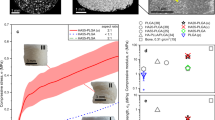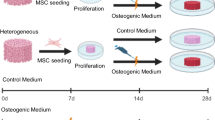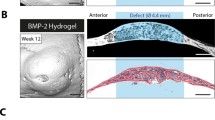Abstract
The formation of bone-like tissue from human mesenchymal stem cells (hMSC) cultured in osteogenic medium on silk fibroin scaffolds was monitored and quantified over 44 days in culture using non-invasive time-lapsed micro-computed tomography (μCT). Each construct was imaged nine times in situ. From μCT imaging, detailed morphometrical data on bone volume density, surface-to-volume ratio, trabecular thickness, trabecular spacing, and the structure model index and tissue mineral density were obtained. μCT irradiation did not impact the osteogenic performance of hMSCs based on DNA content, alkaline phosphatase activity, and calcium deposition when compared to non-exposed control samples. Bone-like tissue formation initiated at day 10 of the culture with the deposition of small mineralized clusters. Tissue mineral density increased linearly over time. The surface-to-volume ratio of the bone-like tissues converged asymptotically to 26 mm−1. Although in vitro formation of bone-like tissue started from clusters, the overall bone volume was not predictable from the time, number, and size of initially formed bone-like clusters. Based on microstructural analysis, the morphometry of the tissue-engineered constructs was found to be in the range of human trabecular bone. In future studies, non-invasive, time-lapsed monitoring may enable researchers to culture tissues in vitro, right until the development of a desired morphology is accomplished. Our data demonstrate the feasibility of qualitatively and quantitatively detailing the spatial and temporal mineralization of bone-like tissue formation in tissue engineering.




Similar content being viewed by others
References
Alsberg E., E. E. Hill, D. J. Mooney. Craniofacial tissue engineering. Crit. Rev. Oral Biol. Med. 12:64–75, 2001
Asakura A., M. Komaki, M. Rudnicki. Muscle satellite cells are multipotential stem cells that exhibit myogenic, osteogenic, and adipogenic differentiation. Differentiation 68:245–253, 2001
Beetz A., G. Messer, T. Oppel, D. van Beuningen, R. U. Peter, P. Kind. Induction of interleukin 6 by ionizing radiation in a human epithelial cell line: control by corticosteroids. Int. J. Radiat. Biol. 72:33–43, 1997
Cartmell S., K. Huynh, A. Lin, S. Nagaraja, R. Guldberg. Quantitative microcomputed tomography analysis of mineralization within three-dimensional scaffolds in vitro. J. Biomed. Mater. Res. A 69:97–104, 2004
Demarteau O., D. Wendt, A. Braccini, M. Jakob, D. Schafer, M. Heberer, I. Martin. Dynamic compression of cartilage constructs engineered from expanded human articular chondrocytes. Biochem. Biophys. Res. Commun. 310:580–588, 2003
Enomoto A., N. Suzuki, Y. Kang, K. Hirano, Y. Matsumoto, J. Zhu, A. Morita, Y. Hosoi, K. Sakai, H. Koyama. Decreased c-Myc expression and its involvement in X-ray-induced apoptotic cell death of human T-cell leukaemia cell line MOLT-4. Int. J. Radiat. Biol. 79:589–600, 2003
Freyria A. M., Y. Yang, H. Chajra, C. F. Rousseau, M. C. Ronziere, D. Herbage, A. J. El Haj. Optimization of dynamic culture conditions: effects on biosynthetic activities of chondrocytes grown in collagen sponges. Tissue Eng. 11:674–684, 2005
Hallahan D. E., E. Dunphy, J. Kuchibhotla, A. Kraft, T. Unlap, R. R. Weichselbaum. Prolonged c-jun expression in irradiated ataxia telangiectasia fibroblasts. Int. J. Radiat. Oncol. Biol. Phys. 36:355–360, 1996
Hildebrand T., A. Laib, R. Müller, J. Dequeker, P. Rüegsegger. Direct three-dimensional morphometric analysis of human cancellous bone: microstructural data from spine, femur, iliac crest, and calcaneus. J. Bone Miner. Res. 14:1167–1174, 1999
Hildebrand T., P. Ruegsegger. Quantification of bone microarchitecture with the structure model index. Comput. Methods Biomech. Biomed. Eng. 1:15–23, 1997
Hofmann S., H. Hagenmuller, A. M. Koch, R. Muller, G. Vunjak-Novakovic, D. L. Kaplan, H. P. Merkle, L. Meinel. Control of in vitro tissue-engineered bone-like structures using human mesenchymal stem cells and porous silk scaffolds. Biomaterials 28:1152–1162, 2007
Hollinger J. O., S. Winn, J. Bonadio. Options for tissue engineering to address challenges of the aging skeleton. Tissue Eng. 6:341–350, 2000
Ishaug S. L., G. M. Crane, M. J. Miller, A. W. Yasko, M. J. Yaszemski, A. G. Mikos. Bone formation by three-dimensional stromal osteoblast culture in biodegradable polymer scaffolds. J. Biomed. Mater. Res. 36:17–28, 1997
Ishaug-Riley S. L., G. M. Crane-Kruger, M. J. Yaszemski, A. G. Mikos. Three-dimensional culture of rat calvarial osteoblasts in porous biodegradable polymers. Biomaterials 19:1405–1412, 1998
Karageorgiou, V., M. Tomkins, R. Fajardo, L. Meinel, B. Snyder, K. Wade, J. Chen, G. Vunjak-Novakovic, D. L. Kaplan. Porous silk fibroin 3-D scaffolds for delivery of bone morphogenetic protein-2 in vitro and in vivo. J. Biomed. Mater. Res. A 78:324–334, 2006
Martin I., D. Wendt, M. Heberer. The role of bioreactors in tissue engineering. Trends Biotechnol. 22:80–86, 2004
Meinel L., R. Fajardo, S. Hofmann, R. Langer, J. Chen, B. Snyder, G. Vunjak-Novakovic, D. Kaplan. Silk implants for the healing of critical size bone defects. Bone 37:688–698, 2005
Meinel L., S. Hofmann, O. Betz, R. Fajardo, H. P. Merkle, R. Langer, C. H. Evans, G. Vunjak-Novakovic, D. L. Kaplan. Osteogenesis by human mesenchymal stem cells cultured on silk biomaterials: comparison of adenovirus mediated gene transfer and protein delivery of BMP-2. Biomaterials 27:4993–5002, 2006
Meinel L., V. Karageorgiou, R. Fajardo, B. Snyder, V. Shinde-Patil, L. Zichner, D. Kaplan, R. Langer, G. Vunjak-Novakovic. Bone tissue engineering using human mesenchymal stem cells: effects of scaffold material and medium flow. Ann. Biomed. Eng. 32:112–122, 2004
Meinel L., V. Karageorgiou, S. Hofmann, R. Fajardo, B. Snyder, C. Li, L. Zichner, R. Langer, G. Vunjak-Novakovic, D. L. Kaplan. Engineering bone-like tissue in vitro using human bone marrow stem cells and silk scaffolds. J. Biomed. Mater. Res. A 71:25–34, 2004
Müller R., T. Hildebrand, P. Rüegsegger. Non-invasive bone biopsy: a new method to analyse and display the three-dimensional structure of trabecular bone. Phys. Med. Biol. 39:145–164, 1994
Müller R., P. Rüegsegger. Micro-tomographic imaging for the nondestructive evaluation of trabecular bone architecture. Stud. Health Technol. Inform. 40:61–79, 1997
Nazarov R., H. J. Jin, D. L. Kaplan. Porous 3-D scaffolds from regenerated silk fibroin. Biomacromolecules 5:718–726, 2004
Neuhof D., A. Ruess, F. Wenz, K. J. Weber. Induction of telomerase activity by irradiation in human lymphoblasts. Radiat. Res. 155:693–697, 2001
Pittenger M. F., A. M. Mackay, S. C. Beck, R. K. Jaiswal, R. Douglas, J. D. Mosca, M. A. Moorman, D. W. Simonetti, S. Craig, D. R. Marshak. Multilineage potential of adult human mesenchymal stem cells. Science 284:143–147, 1999
Risbud M. V., M. Sittinger. Tissue engineering: advances in in vitro cartilage generation. Trends Biotechnol. 20:351–356, 2002
Ritman E. L. Micro-computed tomography-current status and developments. Annu. Rev. Biomed. Eng. 6:185–208, 2004
Rogakou E. P., C. Boon, C. Redon, W. M. Bonner. Megabase chromatin domains involved in DNA double-strand breaks in vivo. J. Cell Biol. 146:905–916, 1999
Rüegsegger P., B. Koller, R. Müller. A microtomographic system for the nondestructive evaluation of bone architecture. Calcif. Tissue Int. 58:24–29, 1996
Seifert B., G. Mihanetzis, T. Groth, W. Albrecht, K. Richau, Y. Missirlis, D. Paul, G. von Sengbusch. Polyetherimide: a new membrane-forming polymer for biomedical applications. Artif. Organs 26:189–199, 2002
Sikavitsas V. I., G. N. Bancroft, J. J. Lemoine, M. A. Liebschner, M. Dauner, A. G. Mikos. Flow perfusion enhances the calcified matrix deposition of marrow stromal cells in biodegradable nonwoven fiber mesh scaffolds. Ann. Biomed. Eng. 33:63–70, 2005
Singh H., S. H. Teoh, H. T. Low, D. W. Hutmacher. Flow modelling within a scaffold under the influence of uni-axial and bi-axial bioreactor rotation. J. Biotechnol. 119:181–196, 2005
Vunjak-Novakovic G., L. Meinel, G. Altman, D. Kaplan. Bioreactor cultivation of osteochondral grafts. Orthod. Craniofac. Res. 8:209–218, 2005
Wang Y., U. J. Kim, D. J. Blasioli, H. J. Kim, D. L. Kaplan. In vitro cartilage tissue engineering with 3D porous aqueous-derived silk scaffolds and mesenchymal stem cells. Biomaterials 26:7082–7094, 2005
Washburn N. R., M. Weir, P. Anderson, K. Potter. Bone formation in polymeric scaffolds evaluated by proton magnetic resonance microscopy and X-ray microtomography. J. Biomed. Mater. Res. A 69:738–747, 2004
Acknowledgments
Financial support from ETH Zurich (TH 26.04-1), the Association for Orthopedic Research (AFOR), and the NIH Tissue Engineering Resource Center are greatly appreciated. We thank Dr. Martin Stauber for help in AVS illustration, Trudel Inc. for silk cocoons, and Wyeth Biopharmaceuticals for BMP-2 supply.
Author information
Authors and Affiliations
Corresponding author
Additional information
Address correspondence to Lorenz Meinel, Institute of Pharmaceutical Sciences, HCI J 392.4, ETH Zurich, Wolfgang-Pauli-Str. 10, 8093 Zurich, Switzerland. Electronic mail: lorenz.meinel@pharma.ethz.ch
Rights and permissions
About this article
Cite this article
Hagenmüller, H., Hofmann, S., Kohler, T. et al. Non-Invasive Time-Lapsed Monitoring and Quantification of Engineered Bone-Like Tissue. Ann Biomed Eng 35, 1657–1667 (2007). https://doi.org/10.1007/s10439-007-9338-2
Received:
Accepted:
Published:
Issue Date:
DOI: https://doi.org/10.1007/s10439-007-9338-2




